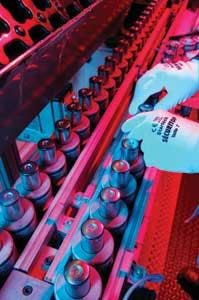MWD tool design advances with high-temperature batteries
Antoine Brenie - Saft Specialty Battery Group
MWD (measurement while drilling) tools provide the operator with real-time information about the tilt and position of the wellbore – particularly important in directional drilling. They also supply detailed information about the conditions at the drill bit, such as rotational speed, torque, weight on the bit, vibration, temperature, and rock formation type.
A direct cable link between the surface and the MWD tool is impractical, so the electronics must be powered by onboard battery systems. The data collected is relayed to the surface either by mud pulse telemetry – the most common technique – or electro-magnetic telemetry.
MWD is a highly demanding application for batteries. These must operate over a wide temperature range – from well below 0° C (32° F) at the surface in Arctic oil and gas exploration projects to well over +100° C (212° F) during drilling. They must also endure very high vibrations, yet provide complete reliability for long periods.
Each time the bottom hole assembly has to return to the surface the downtime costs, depending on drilling depth, can range from $20,000-$200,000. Premature withdrawal to replace a failed MWD battery could therefore add very significant costs to the operation.
Currently, the optimum power solution for MWD tools is a primary battery based on lithium-thionyl chloride (Li-SOCl2) cells such as Saft’s LSH 20 HTS D-size cell – a mechanically enhanced version of a design developed originally for space probes.
Recently, Saft has enhanced this range by developing the new LSH 20 -150 cell, capable of operating at temperatures up to +150° C (302° F) (the previous maximum was +120° C [248° F]). The new cell enables Saft to address the battery needs of the mid-temperature applications (+125° C to +150° C [257° F to 302° F]) that are the most substantial part of the MWD market.
Saft also recently achieved a world first by creating a robust rechargeable Li-ion (lithium-ion) cell capable of charging and discharging at temperatures up to +125° C, while withstanding safely temperatures up to +135° C (275° F). This major advance in Li-ion operating temperature, from the current maximum of +65° C (149° F), opens up new horizons for MWD tool developers and manufacturers.
Today, a typical MWD tool duty cycle requires a primary battery capable of delivering six 10-minute pulse cycles per hour over a drilling operation lasting around 80 hours. The spent primary battery will then need to be replaced.
If, for any reason, the drilling operation has to be stopped early, such as to change the drill bit, and the MWD tool is returned to the surface, then the battery must still be replaced. This ensures that there is a sufficient safety margin of battery power to maintain operation of the MWD tool through to completion. A costly battery could be discarded with half of its capacity unused.
An attractive alternative under development is to substitute the primary battery with a power system incorporating a generator turbine, propelled by the mud flow, which charges a battery employing the fast-charging, deep-discharge and high cycling capability of Li-ion electrochemistry.
Rather than acting as the main source of power, the onboard Li-ion battery functions as an energy buffer. When the mud is flowing the battery is charged. If the flow stops, i.e., when drilling is halted to install a new 90-ft (27.4-m) stand of drill pipes and carry out a survey, the battery powers the MWD electronics. When the flow restarts the battery recharges itself.
Instead of sizing a primary MWD battery to deliver all the power needed for an 80-hr tour of duty, the designer can specify a much smaller, and lighter, rechargeable battery that supports around six to 12 survey measurements between recharges. This is a significant development in technology that has the potential to both revolutionize MWD tool design and simplify rig operations.
Furthermore, the Li-ion battery will last for many operations before it needs replacing. This could eliminate completely the need to withdraw an MWD tool to replace a spent battery, with the benefit of improved continuity for the drilling operation. It is also no problem if a halt in the operation means that the MWD tool has to be brought up early, as the battery will not need to be replaced.


